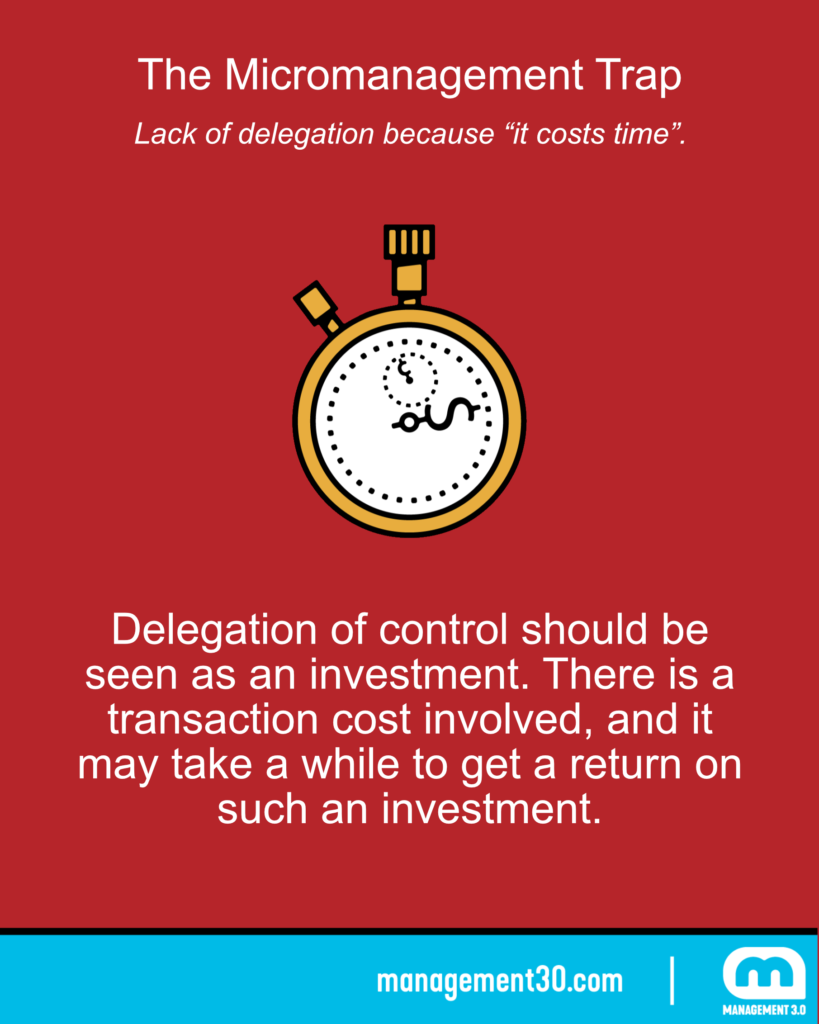An article by Management 3.0 Facilitator Henrique Mata from Brazil who believes in better management and great leaders without micromanagement.
Quick Links:
- What Is Micromanagement?
- What Causes Micromanagement?
- Psychological effects of micromanagement
- How to deal with micromanagement?
If we talk about Management 1.0 we are referring to an old-fashioned management style. In the past, few educated people were in charge of thinking, the others had to implement it. And due to the prevailing image of man, the how was specified exactly and the results were controlled.
It’s like cooking with my mum. When every few minutes she checks actions I have taken and suggests what to do next. Without being asked 🙂
Kasia Więckowska replying to How would you explain “micromanagement” to a 9-years old? on LinkedIn
This approach is far away from our modern interpretation of management and leadership, where individual engagement and empowerment is becoming more and more important.
But in today’s offices micromanagers still exist. These micromanagers interfere in all matters. Like a shadow, they follow the employees every step of the way, prescribe, correct and judge.
Micromanagement has a very negative impact on employees and organizations, and there is a dark side to it all, so let’s look at how to combat micromanagement around the world!
No one likes a micromanager. How maximizing talent rather than focusing on growth is the most important skill we can learn to combat the struggles of remote work.
Listen to: The secret to conscious teams
What Is Micromanagement?
When we talk about micromanagement, we have the lack of leadership and trust of the micromanager. It’s the stereotype of a boss leading by command and control who knows nothing about motivation or delegation.
Micromanagers try to keep as many balls in the air as possible and make themselves indispensable. They interfere in all decisions, take care of every little detail and also take over tasks from employees.
Do you remember when we were driving to see grandmother and you constantly asked “are we there yet?”
Olli-Pekka Manninen replying to How would you explain “micromanagement” to a 9-years old? on LinkedIn
Not all of them do this with the aim of increasing power and making themselves indispensable. Some micromanagers really try to do the right thing. They have good intentions but simply internalize wrong assumptions and beliefs.
Ultimately, this behavior not only leads to the inability to make a difference for micromanagers, but also to the demotivation of employees, who are also less and less productive and effective. This is a vicious cycle that ensures even more is given and controlled.
I would like to encourage managers around the globe who are managing employees, not to fall into the micro-management trap. Don’t be so stressed that your team becomes distributed. Do your best to support teams so that they can deliver, don’t overload them with reporting and monitoring. COVID-19 will be over soon, but our teams are with us for the long run. Rest assured that the teams are looking carefully at how managers operate during this period.
Read on: Shifting work and life into a new corona reality
What Causes Micromanagement?
Often the main cause of micromanagement is the lack of leadership skills and trust in employees. In addition, the fear of losing power and position often plays a major role. Such an environment generates contradicting energies and, according to Tuckman’s law, is always on the storm scale, where team building and empowerment have no place.
I see five common habits of a micromanager:
- A Micromanager thinks he can do a better job at the same time.
- A Micromanager thinks he can do more at the same time.
- A Micromanager likes to correct employees.
- A Micromanager always wants to know who is doing what, where and when.
- A Micromanager thinks employees don’t know as much as him.
What type of manager are you? Do you like to micromanage? Or prefer a hands-off approach? How emotionally invested do you get with your colleagues? Take our quiz and find out what your style is and how that might be perceived from people you work with.

How micromanagement destroys your team: Psychological effects of micromanagement
There are some serious psychological effects to teams which are constantly controlled. Micromanaged people tend to be less productive, because they always feel controlled and corrected. They are constantly being shown that they are not living up to the boss’ expectations.
What if we just explain to them what we’re doing: ‘Did you wash yourself? Did you brush your teeth? Did you clean up your room? Is your homework finished? Really? Are you sure? Can I trust you? You’re not lying?….
Bart Cornelissens replying to How would you explain “micromanagement” to a 9-years old? on LinkedIn
Many people who live in such a toxic environment have very poor personal and professional performance. This is a result of a lack of motivation, a lack of transparency and recognition, and a lack of psychological balance.
How to deal with micromanagement?
Managers who have fallen into the micromanaging trap need to realize that they shouldn’t be managing the people, but the system around them. Here are some starting points that can help create a motivating and engaging framework in which employees can do what they’re hired to do: Their jobs.
#1 Build trust within your team to combat micromanagement
Trust is the basis for everything but especially when it comes to trust in your team members. Management 3.0 offers a whole toolkit of practices to achieve that. Trust comes from knowing the capabilities of your team members. Therefor try out the Team Competency Matrix with your team and make it visible to everyone.
Trust is one of the most important ingredients on any team. See why micromanaging can harm #team dynamics and how you can earn employee trust with these helpful tips.
#2 Leadership cultural change against micromanagement
We cannot change culture directly, but we can make sure that we behave according to clearer and more common principles that lead to culture change. Through delegation and the distribution of responsibility, people learn that each individual is responsible for success and can and must take responsibility. Conversely, this means that people also have the freedom to decide for themselves, to make mistakes and to learn. If people are to feel responsible, we really have to give them responsibility, with all the consequences that come with it.
An important part of managing a remote team is making sure that you prioritize team bonding and spirit building so that employees can work easily together.
Continue reading: Do’s and Don’ts for Remote Leaders
#3 Delegation of roles and responsibility to hinder micromanagement
This is one of the most challenging and at the same time fascinating tasks we have, because once this vicious cycle of micromanagement is broken, the productivity and happiness of the workers will increase. This is where Delegation Poker comes in: This practice helps each employee have their objectives and tasks mapped out, according to the level of the delegation imposed in a collaborative way. We can also use it for groups or teams, always in collaboration with the manager. It is important to point out that we will need autonomy and capacity to achieve maximum efficiency and power among teams, changing the whole corporate climate.
Do you still tend to micromanage? At Management 3.0 we aim for a more powerful system, not better-controlled people.

#4 Proper communication to minimize micromanagement
How to give feedback is one of the most important topics for leaders. Making suggestions right and discussing improvements instead of giving orders. Next time you talk to your employee about their work, try the Feedback Wrap and or the Improvement Dialogue to enhance communication. By building on each other’s contributions, respecting what others have said and responding positively, the discussions are more likely to succeed and bring out the best in everyone.
You can’t really micromanage a team when you’re working from home, you really have to build a foundation of trust.
Listen to Oncalo, CTO of Doist on the Management 3.0 Podcast
In a successful company, we have to think that all employees are leaders, and that managers are mentors in their careers, always encouraging and strengthening their team. A good leader is capable of leading his or her team and organization just by using the fundamentals of leadership, autonomy and constant development.
Nephew, micromanagement is when you ask me to prepare pão-de-queijo and every five minutes you question: “Aunt, is it ready?” “And now aunt, is it ready?” And don’t stop to look at the oven. The pão-de-queijo needs his own time to be perfectly ready, crunchy and gold. He will be ready when was the right time, with no pressure.
Ingrid Souza replying to How would you explain “micromanagement” to a 9-years old? on LinkedIn
Header Photo by Anita Jankovic (Unsplash)



Excellent write up with tremendous insights.
Also Gartner now addresses the problem of micromanagement: https://gtnr.it/3z38NJy